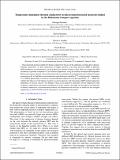Temperature-dependent thermal conductivity in silicon nanostructured materials studied by the Boltzmann transport equation
Author(s)
Romano, Giuseppe; Esfarjani, Keivan; Broido, David; Kolpak, Alexie M.; Strubbe, David
DownloadPhysRevB.93.035408.pdf (554.5Kb)
PUBLISHER_POLICY
Publisher Policy
Article is made available in accordance with the publisher's policy and may be subject to US copyright law. Please refer to the publisher's site for terms of use.
Terms of use
Metadata
Show full item recordAbstract
Nanostructured materials exhibit low thermal conductivity because of the additional scattering due to phonon-boundary interactions. As these interactions are highly sensitive to the mean free path (MFP) of phonons, MFP distributions in nanostructures can be dramatically distorted relative to bulk. Here we calculate the MFP distribution in periodic nanoporous Si for different temperatures, using the recently developed MFP-dependent Boltzmann transport equation. After analyzing the relative contribution of each phonon branch to thermal transport in nanoporous Si, we find that at room temperature optical phonons contribute 17% to heat transport, compared to 5% in bulk Si. Interestingly, we observe a constant thermal conductivity over the range 200 K < T < 300 K. We attribute this behavior to the ballistic transport of acoustic phonons with long intrinsic MFP and the temperature dependence of the heat capacity. Our findings, which are in qualitative agreement with the temperature trend of thermal conductivities measured in nanoporous Si-based systems, shed light on the origin of the reduction of thermal conductivity in nanostructured materials and demonstrate the necessity of multiscale heat transport engineering, in which the bulk material and geometry are optimized concurrently.
Date issued
2016-01Department
Massachusetts Institute of Technology. Department of Materials Science and Engineering; Massachusetts Institute of Technology. Department of Mechanical EngineeringJournal
Physical Review B
Publisher
American Physical Society
Citation
Romano, Giuseppe, Keivan Esfarjani, David A. Strubbe, David Broido, and Alexie M. Kolpak. “Temperature-Dependent Thermal Conductivity in Silicon Nanostructured Materials Studied by the Boltzmann Transport Equation.” Physical Review B 93, no. 3 (January 5, 2016). © 2016 American Physical Society
Version: Final published version
ISSN
2469-9950
2469-9969